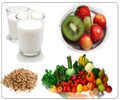The latest study by the UC Davis researchers states that children from the lower income groups can increase their nutrition values by choosing better after school snacks.
The study by the UC Davis team, which is being published in the September issue of the American Journal of Public Health, has bought to light that the lunches offered in school and the vending machines aren't the only places that need to be changed in order to improve the nutrition of the students. The researchers have explained that moderate changes in the kinds of snacks that are being offered at after-school programs would also have a considerable positive impact on children's diets.The study suggests that a healthy snack menu in an after-school program can help low-income children — those at highest risk of obesity — consume more fruit and less saturated fat, said lead author Diana Cassady, an assistant professor of public health sciences at UC Davis.
'Even though school food programs have very limited budgets, this study suggests that with leadership and a little bit of political will, food service for kids really can be improved,' Cassady said.
The UC Davis researchers focused on an after-school program called Students Today Achieving Results for Tomorrow, which serves some 8,000 low-income children from 44 public elementary schools in Sacramento, Elk Grove and Rio Linda.
In 2002, START changed its snack vendor and its menu in an effort to offer more fruits and vegetables, boost nutrition and save money. Kids started receiving more fresh fruit, tastier crackers, more juices and fewer dairy products. For instance, Friday's snack of a brownie and milk was replaced with animal crackers and grape juice; Wednesday's snack of a peach cup and graham crackers was replaced with peanut butter crackers and an apple.
Cassady and her colleagues compared the nutritional content of the new menu of 17 snacks with that of the old menu of 15 snacks. They found that the new menu boosted the children's daily servings of fruit by 83 percent, reduced their daily consumption of saturated fat by 42 percent and cut their overall calorie intake by 7 percent.
Advertisement
'Most START participants receive school breakfasts and lunches that include milk, so as long as children also have a glass of milk or serving of another dairy product at home in the evening, they will meet their daily requirement for calcium and vitamin A,' Cassady said. 'After-school snack menus could also include some low-fat dairy products, or they could add more vegetables, whole grains and legumes, which provide ample amounts of calcium and vitamin A, along with other essential nutrients.'
Advertisement
Richard Lincoln, program manager for Sacramento START, said the changes were well received by students.
'There are kids coming into our program who have never had fresh produce,' Lincoln said. 'We've found that they love getting fresh fruit, and it's been great seeing them discover that they like it.'
If all Americans ate at least five servings of fruits and vegetables a day, cancer rates would drop by more than 20 percent, according to the National Cancer Institute. The NCI based the estimate on a review of 4,500 research studies.
However, only 24 percent of California's children meet the five-a-day recommendation, Cassady said. Even fewer meet the new dietary guidelines that recommend children eat six to seven servings (or 3 to 3.5 cups) of fruit and vegetables each day for better health.
The Sacramento START program is administered by the City of Sacramento's Department of Parks and Recreation and serves six public school districts: Del Paso Heights Elementary School District, Elk Grove Unified School District, Natomas Unified School District, North Sacramento Elementary School District, Rio Linda Union Elementary School District and Sacramento City Unified School District. About 33 percent of START participants are African American, 26 percent are Hispanic, 25 percent are Asian, 14 percent are white and 2 percent are of other race/ethnicity.
UC Davis Cancer Centre is the nation's 61st National Cancer Institute-designated centre, serving a region of more than six million people in the Central Valley and inland Northern California.
Source-Eurekalert
VIK











